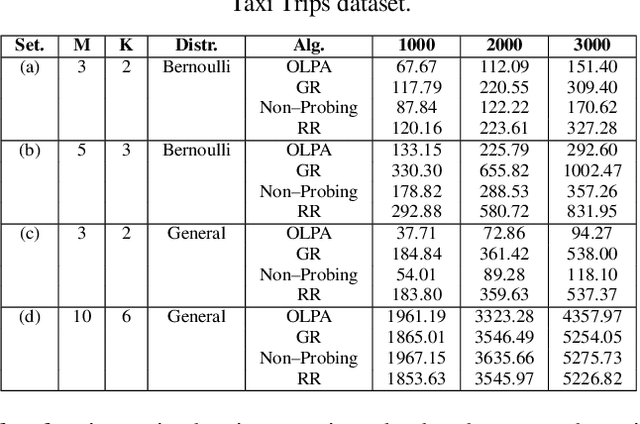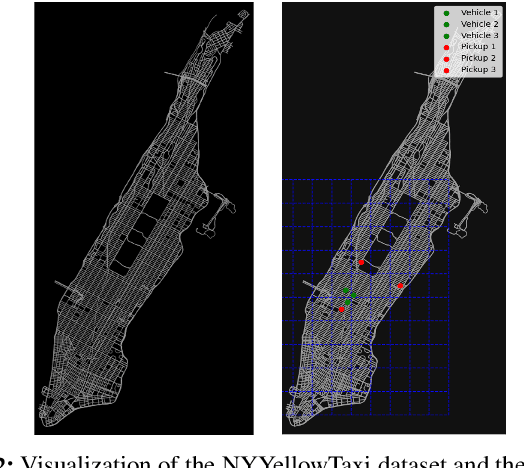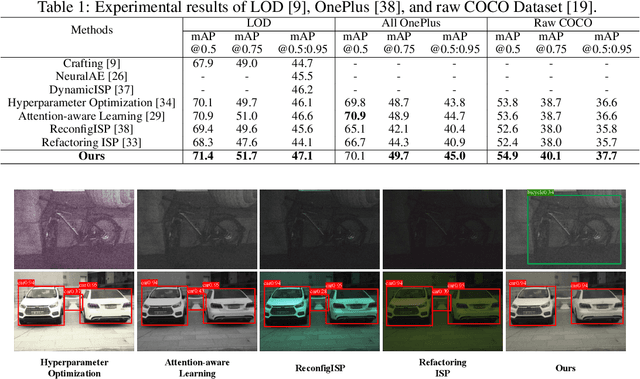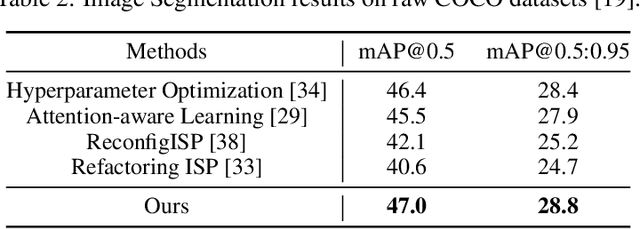Tianyi Xu
StepORLM: A Self-Evolving Framework With Generative Process Supervision For Operations Research Language Models
Sep 26, 2025Abstract:Large Language Models (LLMs) have shown promising capabilities for solving Operations Research (OR) problems. While reinforcement learning serves as a powerful paradigm for LLM training on OR problems, existing works generally face two key limitations. First, outcome reward suffers from the credit assignment problem, where correct final answers can reinforce flawed reasoning. Second, conventional discriminative process supervision is myopic, failing to evaluate the interdependent steps of OR modeling holistically. To this end, we introduce StepORLM, a novel self-evolving framework with generative process supervision. At its core, StepORLM features a co-evolutionary loop where a policy model and a generative process reward model (GenPRM) iteratively improve on each other. This loop is driven by a dual-feedback mechanism: definitive, outcome-based verification from an external solver, and nuanced, holistic process evaluation from the GenPRM. The combined signal is used to align the policy via Weighted Direct Preference Optimization (W-DPO) and simultaneously refine the GenPRM. Our resulting 8B-parameter StepORLM establishes a new state-of-the-art across six benchmarks, significantly outperforming vastly larger generalist models, agentic methods, and specialized baselines. Moreover, the co-evolved GenPRM is able to act as a powerful and universally applicable process verifier, substantially boosting the inference scaling performance of both our own model and other existing LLMs.
Online Learning with Probing for Sequential User-Centric Selection
Jul 27, 2025


Abstract:We formalize sequential decision-making with information acquisition as the probing-augmented user-centric selection (PUCS) framework, where a learner first probes a subset of arms to obtain side information on resources and rewards, and then assigns $K$ plays to $M$ arms. PUCS covers applications such as ridesharing, wireless scheduling, and content recommendation, in which both resources and payoffs are initially unknown and probing is costly. For the offline setting with known distributions, we present a greedy probing algorithm with a constant-factor approximation guarantee $\zeta = (e-1)/(2e-1)$. For the online setting with unknown distributions, we introduce OLPA, a stochastic combinatorial bandit algorithm that achieves a regret bound $\mathcal{O}(\sqrt{T} + \ln^{2} T)$. We also prove a lower bound $\Omega(\sqrt{T})$, showing that the upper bound is tight up to logarithmic factors. Experiments on real-world data demonstrate the effectiveness of our solutions.
Fair Algorithms with Probing for Multi-Agent Multi-Armed Bandits
Jun 17, 2025Abstract:We propose a multi-agent multi-armed bandit (MA-MAB) framework aimed at ensuring fair outcomes across agents while maximizing overall system performance. A key challenge in this setting is decision-making under limited information about arm rewards. To address this, we introduce a novel probing framework that strategically gathers information about selected arms before allocation. In the offline setting, where reward distributions are known, we leverage submodular properties to design a greedy probing algorithm with a provable performance bound. For the more complex online setting, we develop an algorithm that achieves sublinear regret while maintaining fairness. Extensive experiments on synthetic and real-world datasets show that our approach outperforms baseline methods, achieving better fairness and efficiency.
REAL-Prover: Retrieval Augmented Lean Prover for Mathematical Reasoning
May 27, 2025Abstract:Nowadays, formal theorem provers have made monumental progress on high-school and competition-level mathematics, but few of them generalize to more advanced mathematics. In this paper, we present REAL-Prover, a new open-source stepwise theorem prover for Lean 4 to push this boundary. This prover, based on our fine-tuned large language model (REAL-Prover-v1) and integrated with a retrieval system (Leansearch-PS), notably boosts performance on solving college-level mathematics problems. To train REAL-Prover-v1, we developed HERALD-AF, a data extraction pipeline that converts natural language math problems into formal statements, and a new open-source Lean 4 interactive environment (Jixia-interactive) to facilitate synthesis data collection. In our experiments, our prover using only supervised fine-tune achieves competitive results with a 23.7% success rate (Pass@64) on the ProofNet dataset-comparable to state-of-the-art (SOTA) models. To further evaluate our approach, we introduce FATE-M, a new benchmark focused on algebraic problems, where our prover achieves a SOTA success rate of 56.7% (Pass@64).
Leveraging LLM and Self-Supervised Training Models for Speech Recognition in Chinese Dialects: A Comparative Analysis
May 27, 2025Abstract:Large-scale training corpora have significantly improved the performance of ASR models. Unfortunately, due to the relative scarcity of data, Chinese accents and dialects remain a challenge for most ASR models. Recent advancements in self-supervised learning have shown that self-supervised pre- training, combined with large language models (LLM), can effectively enhance ASR performance in low-resource scenarios. We aim to investigate the effectiveness of this paradigm for Chinese dialects. Specifically, we pre-train a Data2vec2 model on 300,000 hours of unlabeled dialect and accented speech data and do alignment training on a supervised dataset of 40,000 hours. Then, we systematically examine the impact of various projectors and LLMs on Mandarin, dialect, and accented speech recognition performance under this paradigm. Our method achieved SOTA results on multiple dialect datasets, including Kespeech. We will open-source our work to promote reproducible research
Large Language Model Compression via the Nested Activation-Aware Decomposition
Mar 21, 2025Abstract:In this paper, we tackle the critical challenge of compressing large language models (LLMs) to facilitate their practical deployment and broader adoption. We introduce a novel post-training compression paradigm that focuses on low-rank decomposition of LLM weights. Our analysis identifies two main challenges in this task: the variability in LLM activation distributions and handling unseen activations from different datasets and models. To address these challenges, we propose a nested activation-aware framework (NSVD) for LLMs, a training-free approach designed to enhance the accuracy of low-rank decompositions by managing activation outliers through transforming the weight matrix based on activation distribution and the original weight matrix. This method allows for the absorption of outliers into the transformed weight matrix, improving decomposition accuracy. Our comprehensive evaluation across eight datasets and six models from three distinct LLM families demonstrates the superiority of NSVD over current state-of-the-art methods, especially at medium to large compression ratios or in multilingual and multitask settings.
Focusing Image Generation to Mitigate Spurious Correlations
Dec 27, 2024



Abstract:Instance features in images exhibit spurious correlations with background features, affecting the training process of deep neural classifiers. This leads to insufficient attention to instance features by the classifier, resulting in erroneous classification outcomes. In this paper, we propose a data augmentation method called Spurious Correlations Guided Synthesis (SCGS) that mitigates spurious correlations through image generation model. This approach does not require expensive spurious attribute (group) labels for the training data and can be widely applied to other debiasing methods. Specifically, SCGS first identifies the incorrect attention regions of a pre-trained classifier on the training images, and then uses an image generation model to generate new training data based on these incorrect attended regions. SCGS increases the diversity and scale of the dataset to reduce the impact of spurious correlations on classifiers. Changes in the classifier's attention regions and experimental results on three different domain datasets demonstrate that this method is effective in reducing the classifier's reliance on spurious correlations.
AdaptiveISP: Learning an Adaptive Image Signal Processor for Object Detection
Oct 30, 2024



Abstract:Image Signal Processors (ISPs) convert raw sensor signals into digital images, which significantly influence the image quality and the performance of downstream computer vision tasks. Designing ISP pipeline and tuning ISP parameters are two key steps for building an imaging and vision system. To find optimal ISP configurations, recent works use deep neural networks as a proxy to search for ISP parameters or ISP pipelines. However, these methods are primarily designed to maximize the image quality, which are sub-optimal in the performance of high-level computer vision tasks such as detection, recognition, and tracking. Moreover, after training, the learned ISP pipelines are mostly fixed at the inference time, whose performance degrades in dynamic scenes. To jointly optimize ISP structures and parameters, we propose AdaptiveISP, a task-driven and scene-adaptive ISP. One key observation is that for the majority of input images, only a few processing modules are needed to improve the performance of downstream recognition tasks, and only a few inputs require more processing. Based on this, AdaptiveISP utilizes deep reinforcement learning to automatically generate an optimal ISP pipeline and the associated ISP parameters to maximize the detection performance. Experimental results show that AdaptiveISP not only surpasses the prior state-of-the-art methods for object detection but also dynamically manages the trade-off between detection performance and computational cost, especially suitable for scenes with large dynamic range variations. Project website: https://openimaginglab.github.io/AdaptiveISP/.
Meta Stackelberg Game: Robust Federated Learning against Adaptive and Mixed Poisoning Attacks
Oct 22, 2024



Abstract:Federated learning (FL) is susceptible to a range of security threats. Although various defense mechanisms have been proposed, they are typically non-adaptive and tailored to specific types of attacks, leaving them insufficient in the face of multiple uncertain, unknown, and adaptive attacks employing diverse strategies. This work formulates adversarial federated learning under a mixture of various attacks as a Bayesian Stackelberg Markov game, based on which we propose the meta-Stackelberg defense composed of pre-training and online adaptation. {The gist is to simulate strong attack behavior using reinforcement learning (RL-based attacks) in pre-training and then design meta-RL-based defense to combat diverse and adaptive attacks.} We develop an efficient meta-learning approach to solve the game, leading to a robust and adaptive FL defense. Theoretically, our meta-learning algorithm, meta-Stackelberg learning, provably converges to the first-order $\varepsilon$-meta-equilibrium point in $O(\varepsilon^{-2})$ gradient iterations with $O(\varepsilon^{-4})$ samples per iteration. Experiments show that our meta-Stackelberg framework performs superbly against strong model poisoning and backdoor attacks of uncertain and unknown types.
SNAP: Stopping Catastrophic Forgetting in Hebbian Learning with Sigmoidal Neuronal Adaptive Plasticity
Oct 20, 2024Abstract:Artificial Neural Networks (ANNs) suffer from catastrophic forgetting, where the learning of new tasks causes the catastrophic forgetting of old tasks. Existing Machine Learning (ML) algorithms, including those using Stochastic Gradient Descent (SGD) and Hebbian Learning typically update their weights linearly with experience i.e., independently of their current strength. This contrasts with biological neurons, which at intermediate strengths are very plastic, but consolidate with Long-Term Potentiation (LTP) once they reach a certain strength. We hypothesize this mechanism might help mitigate catastrophic forgetting. We introduce Sigmoidal Neuronal Adaptive Plasticity (SNAP) an artificial approximation to Long-Term Potentiation for ANNs by having the weights follow a sigmoidal growth behaviour allowing the weights to consolidate and stabilize when they reach sufficiently large or small values. We then compare SNAP to linear weight growth and exponential weight growth and see that SNAP completely prevents the forgetting of previous tasks for Hebbian Learning but not for SGD-base learning.
 Add to Chrome
Add to Chrome Add to Firefox
Add to Firefox Add to Edge
Add to Edge